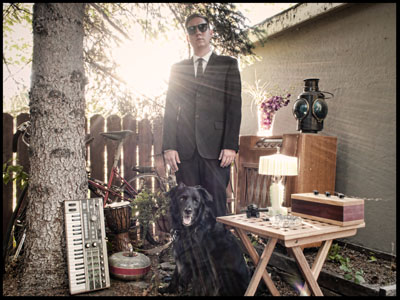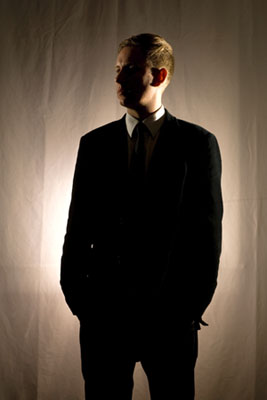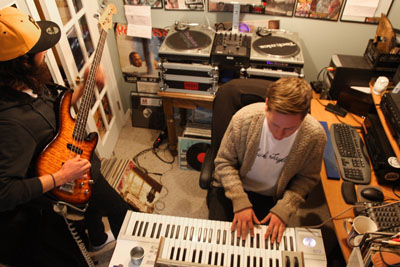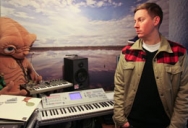"I love Saskatoon!" Factor exclaims as we sit down at the bar of a trendy new coffee shop in Saskatoon's downtown core. A lifelong resident of the city of bridges, Factor, or Factor Chandelier as he's recently been calling himself, is relaxed and jovial, even with a week of constant rain.
"Of course I've thought about what would happen if I moved and spread my wings, but part of me thinks that I'll always be here. And these days travel is so simple. Toronto, Vancouver, Montreal, the States, are all a quick flight away, and with the internet it's crazy how connected you can be." Connecting and connections have been, and still are, a huge part of Factor's career. For over a decade Factor has created a long-term sustainable career in a genre that is still in its infancy. After seeing this producer in action at SXSW in March of this year, I can safely say that Factor's career can be summarized with the following scientific formula:
HUSTLE + MAKE FRIENDS + HUSTLE EVEN HARDER + EMBRACE CHANGE + HUSTLE HARDER STILL + MAKE MORE FRIENDS + RINSE AND REPEAT.
 Factor, or Graham Murawsky by more formal standards, started out in the hip hop scene in the mid-nineties. Originally it was his love for basketball that led him to discover underground hip hop. Beginning with DJ'ing around 1998, he quickly found that his love for basketball was eclipsed by his love of music.
Factor, or Graham Murawsky by more formal standards, started out in the hip hop scene in the mid-nineties. Originally it was his love for basketball that led him to discover underground hip hop. Beginning with DJ'ing around 1998, he quickly found that his love for basketball was eclipsed by his love of music.
"We used to head to the Vinyl Diner and grab whatever underground hip hop we could, because back then there wasn't very much available in Saskatoon."
Sourcing the original vinyl records his heroes used to create tracks helped Factor deconstruct hip hop beats, and sparked his lifelong obsession with production.
As Factor got more into production he quickly graduated from DJ'ing and mixing to creating his own beats. It's worth noting that at this point there were no computers involved. Factor was working on a start/stop tape player and a 2-channel mixer, creating his own flavor of underground hip hop. Samplers were quickly added to his rapidly expanding set of DJ gear as Factor and his friends forged deeper into the scene.
This quest for new underground hip hop is a key characteristic of Factor: He never stops learning. He's never satisfied with the status quo. It's this restlessness, this wanting, that has been his silent compass for the last 15 years. It's led him to find the answers in hip hop and provided him with the opportunities to grow as an artist.
In his final year of high school, Factor began creating mixtapes, selling them out of his car (CD-R style), and performing regularly around the city. Connecting with a local underground hip hop radio show on CFCR called Third Verse, he began to learn more about the underground hip hop scene and where he fit in.
Factor's first proper album came out in 2001, "Time Invested". A full-length album is a milestone in any artist's career, but during this time Factor was also running his own record store, Kno Static Records. Kno Static was an exclusively underground hip hop store and found its momentum in the growing strength of not only the Saskatoon scene, but in the growing dominance of hip hop on the mainstream charts.
Through 2002 the momentum and the awareness of Factor's production and DJ skills reached more ears. Tours of the west began and quickly that momentum spilled across Canada. "It was a real special niche. Nobody knew about it, but it was big enough that my store was going, promoters were bringing in bigger artists from L.A., shows were coming from further away, and then we did the a full Canadian tour." It was on this tour that Factor made a crucial connection with Los Angeles-based rapper Awol One.
Awol One is a member of the legendary Shape Shifters crew. His music has been featured on MTV, in magazines such as URB and Spin, and he has collaborated with artists such as KRS one, Kool Keith and Atmosphere. But one of Awol One's most fruitful collaboration has been with Factor. Their symbiotic relationship was officially christened with the release of a 7" single called "Try" in 2003.
Try features a soft Spanish guitar loop, while a delicate flute floats over top of a chilled out beat. On Try (check out both the instrumental and official version on YouTube), Factor's smooth production is a perfect counterpoint to Awol One's lyrics, and the perfect addition to Awol One's flow. If you're unfamiliar with Factor's work, start with Try, and the rest will make sense.
Try started buzzing in Los Angeles and, seizing this opportunity, Factor visited the city for some promotional dates and recorded "Only Death Can Kill You", the first official album with Awol One. The release was picked up by Sublime's record label, Cornerstone, and the momentum kept building. From 2003 onward, Factor was working with more American artists and becoming an in-demand underground producer.
But this wasn't enough for Factor. During this time he not only was releasing compilation beat tapes, but he started his own record label called Side Road Records. Side Road Records was a masterstroke for Factor, as not only has it been terrific for his own career, but it has nurtured and incubated the careers of several local acts such as Kay the Aquanaut, Def 3 and Nolto, just to name a few. As Factor puts it, he was "just trying to do it."
This brings up another important characteristic of Factor: He's possibly the most prolific hip hop artist to ever come out of the prairies. Since 2000, he's released, or been a part of, at least 3 releases per year(!) In fact, Factor has arguably become MORE prolific in the last 4 years than he had been when he first started grinding!
 A big reason for Factor's impressive release schedule is that he is in control of everything. Even though Side Road Records and Factor have had deals with other labels, Side Road continues to thrive as Factor builds bridges between his distributors, his artists, and his fans, and seizes the opportunities that his many collaborations give him.
A big reason for Factor's impressive release schedule is that he is in control of everything. Even though Side Road Records and Factor have had deals with other labels, Side Road continues to thrive as Factor builds bridges between his distributors, his artists, and his fans, and seizes the opportunities that his many collaborations give him.
One of the more successful Side Road collaborations has been with Bay Area artist Kirby Dominant. The music Factor and Kirby Dominant create together might just be the catchiest underground hip hop you've ever heard. Over top of some of Factor's best work, Kirby raps about love, life, and loss, leaving the listener feeling better at the end of it. It's the kind of music that could easily blow up across the world.
This year at South by Southwest, Kirby was called in for a huge favor when Factor found himself in an unfortunate situation. He was scheduled to play his first SXSW with Awol One, but tragedy struck. A member of Awol One's family passed away in the days leading up to the international festival. After months of planning and countless hours of work, Factor's SXSW appearance was in question.
With Awol One's blessing, Factor called up Kirby Dominant and the two blazed on. In the midst of Austin's music week insanity, I met up with Factor and he explained to me that his trip had been a bittersweet experience. "I'm stoked to be here feeding off the energy with Kirby, but it's weird without Awol One." The showcase was a huge success, and after the gig I spoke with Kirby, who echoed Factor's feelings.
The successes of 2012 have been a long time coming, but Factor feels like his breakout year was back in 2008. After being signed to Fake Four in 2007 (an East Coast American label), he found himself sitting on a new record ("Chandelier") that he didn't know what to do with it. He reached out to Fake Four's founder Ceschi Ramos for a collaboration that proved to be a deft move. "Ceschi was, and still is, one of my heroes, so when I sent him Chandelier, he called me back later that night and said it was going to be Fake Four's second release. I was like, Really?" That record changed the game for Factor. The momentum that he had built since the late nineties reached another level and according to Factor, "the opportunities just kept coming with Fake Four."
Getting back together with Awol One for the album "Owl Hours", Factor started working with Xzibit (yeah, the Pimp My Ride Xzibit). After Xzibit executive produced the record, the hype exploded in Los Angeles. "We played a sold-out show at the Knitting Factory, and as soon as Xzibit hit the stage, Boom. Thousands of cell phones cameras popped up." When pressed about why he didn't move to the Golden State, Factor once again cites his love of Saskatoon and the things it holds as his reason for staying...at least for now.
In many ways, Factor is a classic Saskatchewan artist. He's a world-class talent, still humble, still hungry, but wanting to make it work from Saskatoon, not another city.
Factor talks about a certain mystique that the location provides. "When I go down there (L.A.) I'm The Canadian. You know, it's unique. If I moved down there, who knows what would happen?" This practical approach to his career has helped Factor become the sustainable artist he is today. In demand, but able to take on projects for their artistic merit rather than just to pay bills. But he acknowledges that living within your means is a powerful thing for an artist. "I'm able to have these new experiences; traveling, working with other people all over the world. I'm not a millionaire but life is good." Factor is in an enviable position for any artist, let alone one who works in a niche.
The only reason Factor has been able to get to this point is because his hustle never stops. "For a while I wasn't on Facebook. I wasn't signing up for the new things. Then I was like, "man, I can't get old and irrelevant.' So I started using social media. Instagram, Twitter, all that stuff, and it generates a whole new fan base." Through embracing social media, along with his early adoption of music videos as a tool, Factor has found an expanded audience.
If you're near a computer or a smart phone, do yourself a favour and YouTube some of Factor's videos. They're slick, stylish, and tell the story of Factor in a way that is understandable yet artistic. Early on, Factor teamed up with acclaimed videographer Stuey Kubrick. The two instantly developed a close friendship, and there has been some truly amazing work created. On Factor's collaboration with Gregory Pepper, "Common Grackle" (2010), the clear evidence of Saskatoon as a backdrop provides a haunting salute to his hometown. "Those videos helped me out so much. And now I heard that Stuey got a RED camera! But his rates will probably go up, so..." Factor says with a laugh.
 Through his warm and inviting personality, tenacious work ethic, and undeniable talent, Factor has been able to create an impressive career from the city that he loves. Each year Factor's momentum builds, and he confessed that he is excited his popularity in Saskatchewan is growing. This year, Factor will head to Ness Creek, play MoSo Fest, and he's already released his collaboration with local phenomenon Jeans Boots under his Club Soda Series.
Through his warm and inviting personality, tenacious work ethic, and undeniable talent, Factor has been able to create an impressive career from the city that he loves. Each year Factor's momentum builds, and he confessed that he is excited his popularity in Saskatchewan is growing. This year, Factor will head to Ness Creek, play MoSo Fest, and he's already released his collaboration with local phenomenon Jeans Boots under his Club Soda Series.
Walking into Factor's studio, one of the first things you see is a massive photo by Kaid Asthon of the open prairie sky covering one entire wall. It's clear that his hometown and province play a big role in who Factor is. As he plays me some new tracks from an upcoming Factor and the Chandeliers record, he's visibly excited for what his future holds, especially when it comes to the Chandeliers.
Factor and the Chandeliers are a group that features Enver Hampton, Levi Soloudre, and a slew of other solid musicians as Factor's "Chandeliers". The Chandeliers are part of a plan to move away from samples and focusing more on his own original creations. "I still DJ shows, but a few years ago I was asked to be part of a big movie soundtrack. The track they wanted contained a sample we couldn't get cleared in time," Factor explains with frustration. Seeing how much that experience held him back, Factor began producing his own creations from the ground up. The Chandeliers record is his first live band project, and judging by the response, it won't be his last.
After a few hazy hours of discussing his life and his music, I leave Factor's studio with a buzz. This guy has found a global audience from his base in Saskatoon, he's embraced the changes of the music industry, and understood that to stay connected with his audience he needs to keep creating solid content. Not an easy task. But Factor just puts his head down and keeps creating music, keeps hustling, and keeps making friends, which will no doubt bring him even more success.
For more on Factor, visit:
By Matthew Wojnarowicz for SaskMusic. Originally published Summer-Autumn 2012 issue of The Session. This article is posted as initially published. For reprint/usage permission or any other questions, please contact SaskMusic.
Photo Credits:
1.) Chad Coombs
2.) Owen Woytowich
3.) Kaid Ashton (with Enver Hampton)
4.) Owen Woytowich









